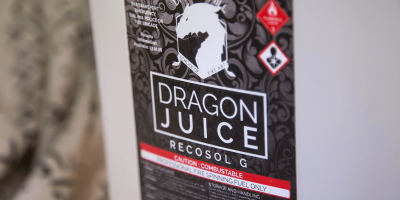ISSUE: 5 ISSUE DATE: 03/06/2015
SAFETY DATA SHEET
SECTION 1 IDENTIFICATION: PRODUCT IDENTIFIER AND CHEMICAL IDENTITY
| Product Identifier | RECOSOL G |
| Other Names | Isoparaffin |
| Manufacturer’s Product Code | 16555 |
| Recommended Use | Solvent |
Details of Supplier/Manufacturer
| Company: | Recochem Inc. ABN: 69 010 485 999 |
| Address: | 1809 Lytton Road, Lytton, Queensland 4178 |
| Phone: | (07) 3308 5200 Fax: (07) 3308 5201 |
| Website: | www.recochem.com.au |
Emergency Telephone Numbers
| Business Hours: | (07) 3308 5200 |
| After Hours: | 1300 131 001 |
| Poisons Information: |
Australia: 13 11 26 New Zealand: 0800 764 766 |
SECTION 2 HAZARDS IDENTIFICATION
| Hazardous chemical | according to classification by Safe Work Australia | |
| Dangerous goods | according to the Australian Code for the Transport of Dangerous Goods by Road and Rail |
|
| Signal Word | DANGER | |
| GHS Classification | Pictogram | Hazard statement |
| Flammable Liquids, Category 3 |
FLAME | H226 Flammable liquid and vapour |
| Aspiration Hazard, Category 1 |
HEALTH HAZARD | H304 May be fatal if swallowed and enters airways |
Product: RECOSOL G
| Precautionary statements: | |
| GENERAL | |
| P101 | If medical advice is needed, have product container or label at hand |
| P102 | Keep out of reach of children |
| P103 | Read label before use |
| PREVENTATIVE | |
| P210 | Keep away from heat/sparks/open flames/hot surfaces. – No smoking |
| P233 | Keep container tightly closed |
| P240 | Ground/bond container and receiving equipment |
| P241 | Use explosion-proof electrical/ventilation/lighting equipment |
| P242 | Use only non-sparking tools |
| P243 | Take precautionary measures against static discharge |
| P280 | Wear protective gloves/eye protection/face protection |
| RESPONSE | |
| P301 + P310 | IF SWALLOWED: Immediately call a POISON CENTER or doctor/physician |
| P303 + P361 + P353 |
IF ON SKIN (or hair): Take off contaminated clothing and wash before reuse. Rinse skin with water/shower |
| P331 | Do NOT induce vomiting |
| P370 + P378 | In case of fire: Use foam/water spray/fog for extinction |
| STORAGE | |
| P403 + P235 | Store in a well-ventilated place. Keep cool |
| P405 | Store locked up |
| DISPOSAL | |
| P501 | Dispose of contents/container in accordance with local regulations |
SECTION 3 COMPOSITION AND INFORMATION ON INGREDIENTS
Ingredients Names and Proportions
| Chemical Entity | CAS Number | Proportion (%) |
| Naphtha (petroleum), hydrotreated heavy; Low boiling point hydrogen treated naphtha |
64742-48-9 | 100 |
| Note – product contains < 0.1% benzene |
SECTION 4 FIRST AID MEASURES
Description of necessary first aid measures
| Inhalation: | Remove victim from exposure if safe to do so. If rapid recovery does not occur, transport to nearest medical facility for additional treatment. Remove contaminated clothing. |
| Skin Contact: | If skin contact occurs, remove contaminated clothing and wash skin thoroughly with water and follow by washing with soap if available. |
| Eye Contact: | If in eyes, hold eyes open, flood with water for at least 15 minutes. If symptoms persist transport to nearest medical facility for additional treatment. |
| Ingestion: | If swallowed, do NOT induce vomiting. Transport to nearest medical facility for additional treatment. If vomiting occurs spontaneously, keep head below hips to prevent aspiration. |
Symptoms caused by exposure
| Inhalation: | Breathing of high vapour concentrations may cause central nervous system depression resulting in headaches, dizziness and nausea; continued inhalation may result in unconsciousness and/or death. |
| Skin: | May include redness and dryness. |
| Eye: | May include burning sensation and redness. |
| Ingestion: | May include coughing, choking, wheezing, difficulty in breathing, chest congestion, shortness of breath and/or fever. |
Medical attention and special treatment
Treat symptomatically.
SECTION 5 FIRE FIGHTING MEASURES
Suitable extinguishing equipment
Foam, water spray or fog, dry chemical powder. Do not use water in a jet.
Specific hazards arising from the chemical
Will float and can be reignited on surface water. Vapour is heavier than air, can spread along ground and
distant ignition is possible.
Special protective equipment and precautions for fire fighters
Wear full protective clothing and self-contained breathing apparatus. Hazchem code ●3Y.
SECTION 6 ACCIDENTAL RELEASE MEASURES
Personal precautions, protective equipment and emergency procedures
Avoid contact with spilled or released material. Shut off leaks, if possible without personal risks. Isolate
hazard area and deny entry to unnecessary or unprotected personnel. Remove all sources of ignition in the
surrounding area. Take precautionary measure against static discharge. Ensure electrical continuity by
bonding and earthing all equipment.
Environmental precautions
Use appropriate containment to avoid environmental contamination. Prevent from spreading and entering
waterway using sand, earth or other appropriate barriers. Attempt to disperse the vapour or to direct its flow
to a safe location for example by using fog sprays. Ventilate contaminated area thoroughly.
Methods and materials for containment and cleaning up
For small spills (< 1 drum), transfer by mechanical means to a labelled, sealable container for product
recovery or safe disposal. Allow any residues to evaporate or use an appropriate absorbent material and
dispose of safely.
For larger spills (> 1 drum), transfer by means such as a vacuum truck to a salvage tank for recovery or
disposal. Do not flush residues with water. Retain as contaminated waste. Allow any residues to evaporate or
use an appropriate absorbent material and dispose of safely.
SECTION 7 HANDLING AND STORAGE
Precautions for safe handling
Flammable product. Avoid breathing vapours. Handle and open containers with care in a well-ventilated area.
Ensure that the workplace is ventilated such that the Occupational Exposure limit is not exceeded. Avoid
contact with skin, eyes and clothing. Wash thoroughly after handling. Do not eat, drink or smoke in
contaminated areas. Electrostatic charges may be generated during transfer. Electrostatic discharge may
cause fire. Ensure electrical continuity by earthing all equipment.
Conditions for safe storage, including any incompatibilities
Store in a well-ventilated area, away from sunlight, ignition sources and other sources of heat. Do not store
near strong oxidants.
SECTION 8 EXPOSURE CONTROLS AND PERSONAL PROTECTION
Exposure control measures
Product contains Nonane.
From National Occupational Health & Safety Commission (NOHSC) Worksafe Australia –
Nonane: 1050mg/m³ (200ppm) TWA (8hr)
Biological monitoring
No biological limit allocated.
Engineering controls
Ensure that adequate ventilation is provided. Maintain air concentrations below recommended exposure
standards. Avoid generating and inhaling mists and vapours. Keep containers closed when not in use.
Individual protection measures
| Eye and face protection: | Wear safety goggles. |
| Skin protection: | Use solvent resistant gloves, nitrile for longer term protection or PVC and neoprene for incidental splashes. |
| Respiratory protection: | If work practices do not maintain airborne level below the exposure standard, use appropriate respiratory protection equipment. When using respirators, select an appropriate combination of mask and filter. Select a filter for organic gases and vapours (boiling point > 65°C). Respirators should comply with AS1716 or an equivalent approved by a state/territory authority. |
| Thermal hazards: | Not applicable. |
SECTION 9 PHYSICAL AND CHEMICAL PROPERTIES
| Appearance: | Colourless liquid |
| Odour: | Isoparaffinic hydrocarbon odour |
| Odour threshold (ppm): | Data not available |
| pH: | Data not available |
| Melting point/freezing point (°C): | Data not available |
| Initial boiling point and boiling range (°C): | Typical 153 – 179 |
| Flash point (°C): | 40 (CC) |
| Evaporation rate (Butyl acetate = 1): | Data not available |
| Flammability: | Flammable |
| Upper/lower flammability or explosive limits (%): | 0.7 – 5.6 |
| Vapour pressure (kPa @ 20°C): | 0.231 |
| Vapour density (air = 1): | > 1 |
| Density (g/ml @ 15°C): | 0.75 |
| Solubility (Wt%): | 0.1 |
| Partition coefficient: n-octanol/water: | Data not available |
| Auto-ignition temperature (°C): | Typical 365 |
| Decomposition temperature (°C): | Data not available |
| Kinematic viscosity (mm2/s @ 20°C): | Data not available |
SECTION 10 STABILITY AND REACTIVITY
Reactivity
Stable under normal conditions of use.
Chemical stability
Stable under normal conditions of use.
Possibility of hazardous reactions
Stable under normal conditions of use.
Conditions to avoid
Avoid heat, sparks, open flames and other ignition sources.
Incompatible materials
Strong oxidising agents.
Hazardous decomposition products
None.
SECTION 11 TOXICOLOGICAL INFORMATION
| Acute toxicity: | Expected to be of low toxicity. |
| Skin corrosion/irritation: | Mild irritant. Prolonged contact may cause defatting of skin which can lead to dermatitis. |
| Serious eye damage/irritation: |
Will cause discomfort but will not damage eyes tissue. |
| Respiratory or skin sensitisation: |
Not expected to be a sensitiser. |
| Germ cell mutagenicity: | Not expected to be mutagenic. |
| Carcinogenicity: | Not expected to be carcinogenic. |
| Reproductive toxicity: | Not expected to impair fertility. |
| Specific Target Organ Toxicity (STOT) – single exposure: |
Inhalation of vapours or mists may cause irritation to the respiratory system. Vapour concentrations above recommended exposure levels may be irritating to the eyes and the respiratory tract, may cause headaches, dizziness and may have other central nervous system effects. |
| Specific Target Organ Toxicity (STOT) – repeated exposure: |
Data not available |
| Aspiration hazard: | Aspiration into the lungs when swallowed or vomited may cause chemical pneumonitis which can be fatal. |
SECTION 12 ECOLOGICAL INFORMATION
Ecotoxicity
| Acute toxicity: | |
| Fish – | Expected to be toxic |
| Aquatic invertebrate – | Expected to be toxic |
| Algae – | Expected to be toxic |
| Microorganisms – | Expected to be toxic |
| Chronic toxicity: | |
| Fish – | Data not available |
| Aquatic invertebrate – | Data not available |
| Algae – | Data not available |
| Microorganisms – | Data not available |
Persistence and degradability
Readily biodegradable. Degrades rapidly in air.
Bioaccumulative potential
Has the potential to bioaccumulate.
Mobility in soil
Floats on water, highly volatile and will evaporate rapidly if released into water.
Other adverse effects
Data not available.
SECTION 13 DISPOSAL CONSIDERATIONS
Ensure waste disposal conforms to local waste disposal regulations.
SECTION 14 TRANSPORT INFORMATION
| UN number: | 1993 |
| Proper shipping name: | Flammable Liquid N.O.S. |
| Australian Dangerous Goods class: | 3 |
| Australian Dangerous Goods packing group: | III |
| Hazchem code: | ●3Y |
SECTION 15 REGULATORY INFORMATION
| Standard for the Uniform Scheduling of Medicines and Poisons (SUSMP), Poisons Schedule: |
5 |
| Australian Inventory of Chemical Substances (AICS): |
Listed |
| Dangerous Goods Initial Emergency Response Guide (SAA/SNZ HB76): |
14 |
SECTION 16 OTHER INFORMATION
| Date of preparation: | 03/06/2015 |
| Revision number: | 5 |
| Changes in this revision: | Update to GHS SDS standard |
This MSDS summarises product safety information at the date of issue, to the best of our knowledge, as a general guide. Recochem cannot
anticipate or control the conditions under which the product is used, so prior to usage each user must assess and control the risks associated
with their use of the product. Users should also consult the relevant legislation governing the use and storage of this product. We make no
warranties, express or implied, and assume no liability in connection with any use of information contained within this document. If clarification or
further information is needed, the user should contact Recochem on (07) 3308 5200.















